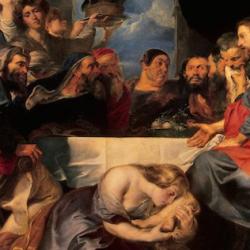Based on LXX evidence, Bailey argues that the word translated as “safe and sound” should be translated as “in peace” (the word translates SHALOM in 10 of 11 uses in the LXX, and translates SHALAM in the 11th use). The feast is a festival of reconciliation and peace, covenant renewal. In fact, there is perhaps a sacrificial sequence in the whole story: The story is about a “son” (cf. “son of the herd” in Lev 1); the son is separated from his house and father (slaughter), but comes to life and returns to be clothed in glory (turned to smoke) and to be offered a feast. The whole sequence is a peace offering. That, and some of the thoughts in my previous post, make me think that Barth’s use of this parable is sound: He describes the Son’s journey into the world as the “Son’s journey into a far country.” Jesus is probably the father in the parable, but in some sense Jesus is also the prodigal himself, who undergoes exile from his father’s house, who is sacrificed, to reconcile the Father with his son, the “younger son” who is despised by the Adamic “elder son(s)” of Israel. Jesus is Jacob the prodigal; but the elder son is no Esau.















